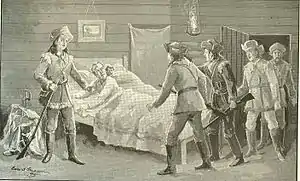Philippe-François de Rastel de Rocheblave
Philippe-François de Rastel de Rocheblave also, known as, Philippe de Rocheblave and the Chevalier de Rocheblave (March 23, 1727 – April 3, 1802), was a soldier and businessman in the Illinois Country, of Upper Louisiana, and later, a political figure in Lower Canada. He was sometimes referred to as the Chevalier de Rocheblave.
Philippe-François de Rastel de Rocheblave | |
|---|---|
 Philippe de Rocheblave, the commandant of Fort Gage, captured in bed, with his wife, by Colonel George Rogers Clark and the Illinois Regiment, Virginia State Forces, in 1778, who seized the lightly guarded British outpost, of Kaskaskia, in the Illinois Country | |
| Born | March 23, 1727 Savournon, Hautes-Alpes, France |
| Died | April 3, 1802 |
| Nationality | French, Canadian |
| Other names | Philippe de Rocheblave, Chevalier de Rocheblave |
| Occupation | soldier, colonial army officer, trader, colonial militia officer, fur trader, politician |
| Spouse(s) | Marie Louise Dufresne |
| Children | Noël de Rastel de Rocheblave (son), Pierre de Rastel de Rocheblave (son) |
| Parent(s) | Jean Joseph de Rastel de Rocheblave and Diane Elizabeth Dillon |
| Relatives | Jacques Michel du Fresne (father-in-law), Marie Francoise Henry (father-in-law) |
Early life
Philippe-François de Rastel de Rocheblave was born in Savournon, Hautes-Alpes, France.
Illinois Country, Upper Louisiana Territory
Philippe de Rocheblave served in the French Army. Rocheblave led French troops in New France, during the Seven Years' War also, known as, the French and Indian War in North America, serving as a lieutenant at Fort de Chartres in the Illinois Country. He later established a business at Kaskaskia. After the British took control of Kaskaskia, he became the commandant of Fort Sainte-Geneviève, in the Illinois Country for New Spain. In 1774, Rocheblave took command of Kaskaskia, for the British.
American Revolutionary War
In 1778, during the American Revolutionary War, Colonel George Rogers Clark, commander of the Illinois Regiment, Virginia State Forces, captured Kaskaskia for the Americans and took Philippe de Rocheblave prisoner.[1] Rocheblave was sent to Virginia, where he eluded parole and fled to the British forces in New York City.
Post-War years and death
According to Robert MacIntosh's 2006 book "Earliest Toronto", after the American Revolutionary War ended, Rocheblave first settled in Upper Canada, where Lord Dorchester, the Governor-General approved a grant of 1000 acres on the banks of the Humber River.[2] However, the grant stalled when it fell to John Graves Simcoe, the Lieutenant Governor of Upper Canada, and his appointees, to process it, and specify the actual acres that should have been his.
Philippe de Rocheblave then brought his family to Montreal; they later settled at Varennes in 1789. He became involved in the fur trade in the Detroit region. In 1796, Rocheblave was elected to the Legislative Assembly of Lower Canada for Surrey and was re-elected in 1796 and 1800, serving until his death in 1802. The sons of Rocheblave, Noël and Pierre, also, became members of the legislative assembly. Pierre de Rastel de Rocheblave also, became a member of the Lower Canada Legislative Council. Philippe de Rocheblave died on April 3, 1802, in Quebec City, Lower Canada.
References
- Thwaites, Reuben Gold (1903). How George Rogers Clark won the Northwest, and other essays in western history. Chicago: A.C. McClurg & Co. pp. 27–33. Retrieved January 1, 2016.
-
Robert MacIntosh (2006). Earliest Toronto. GeneralStore PublishingHouse. p. 11. ISBN 9781897113417. Retrieved 2019-03-30.
Philippe de Rocheblave was another French survivor, a fascinating figure who figures prominently in Percy Robinson's account of Toronto in the late eighteenth century. Indeed he devotes an Appendix to de Rocheblave, written by Fabre Surveyer, a judge and scholar in Quebec.
External links
- "Biography". Dictionnaire des parlementaires du Québec de 1792 à nos jours (in French). National Assembly of Quebec.
- Famille de Rastel de Rocheblave
